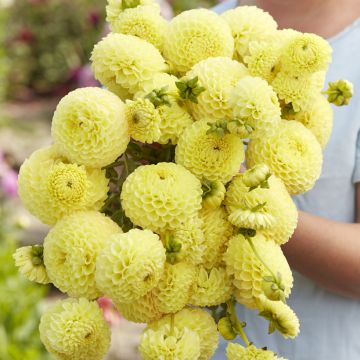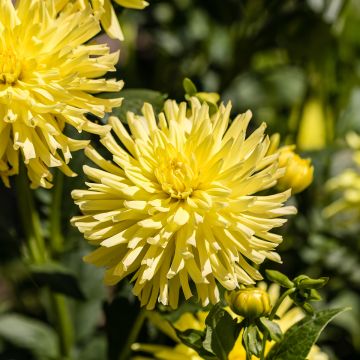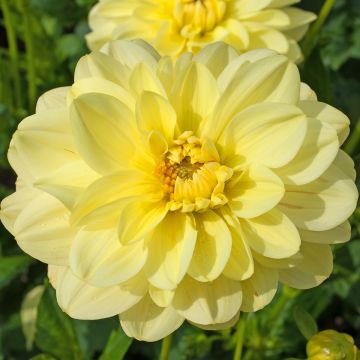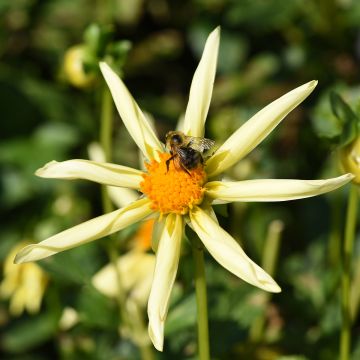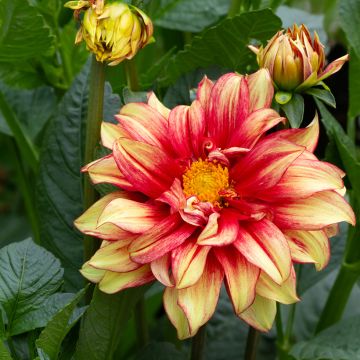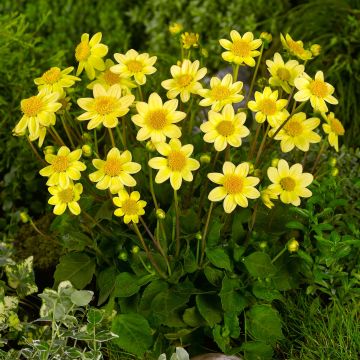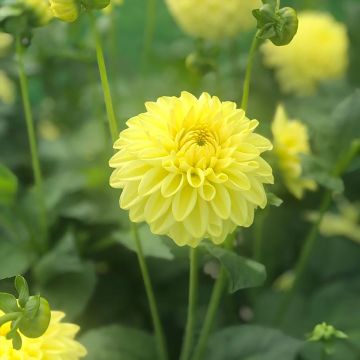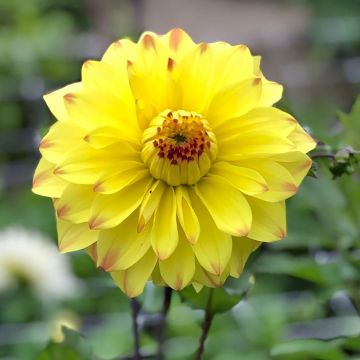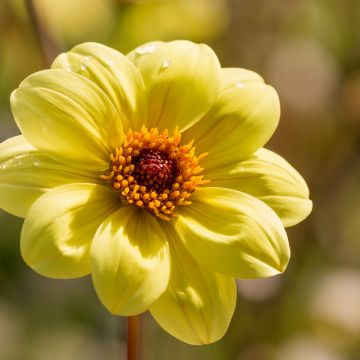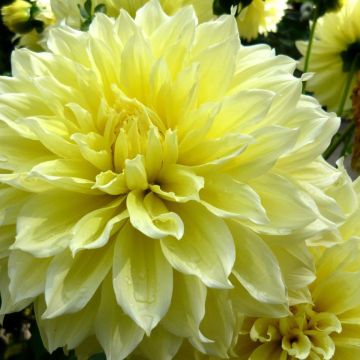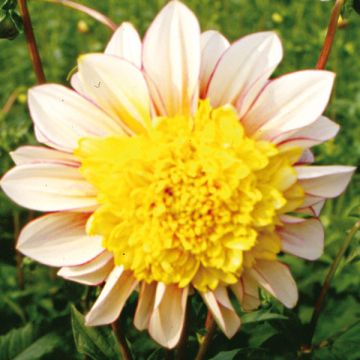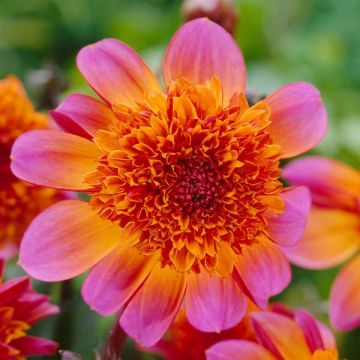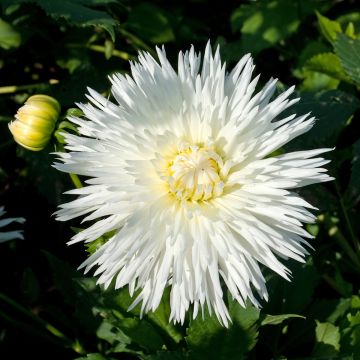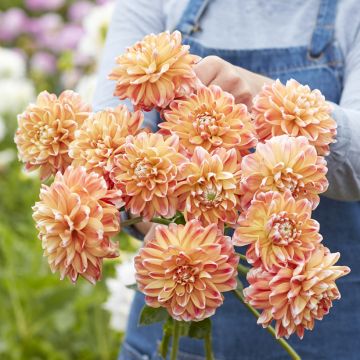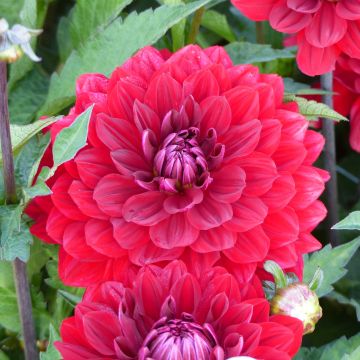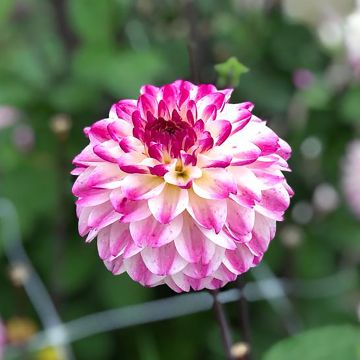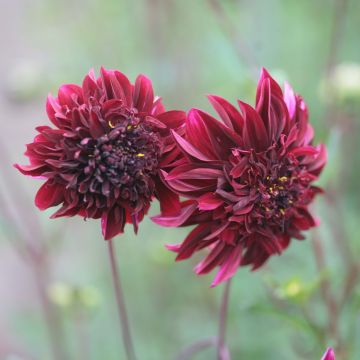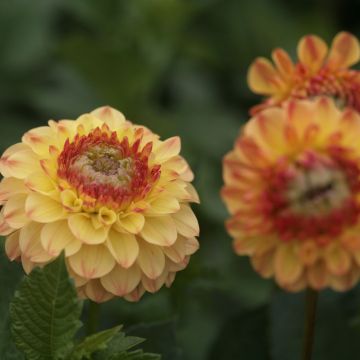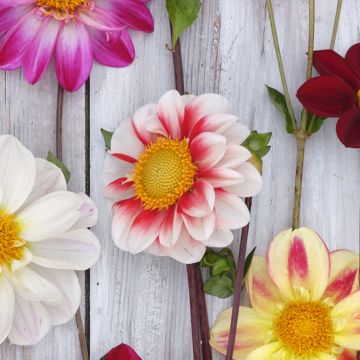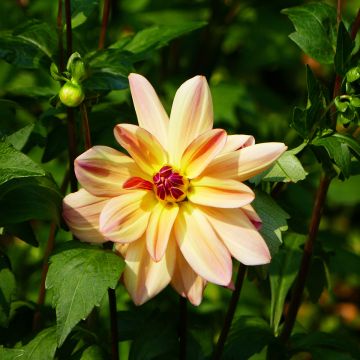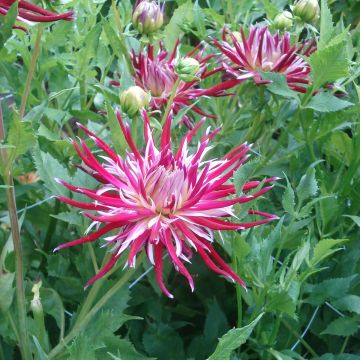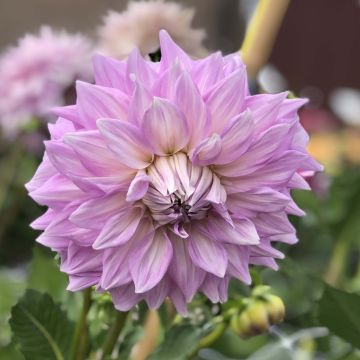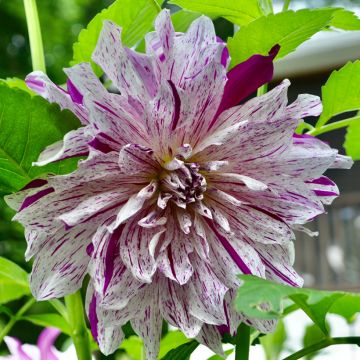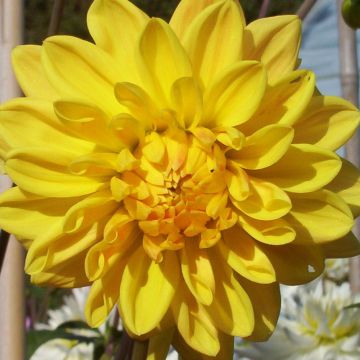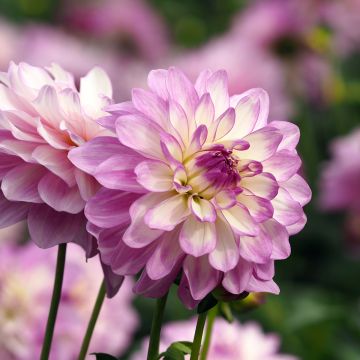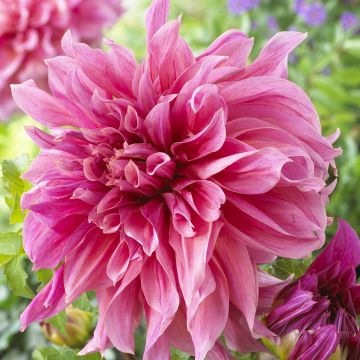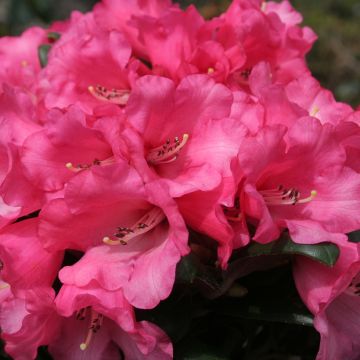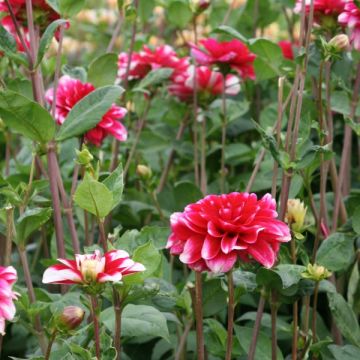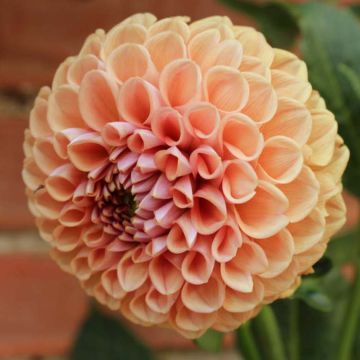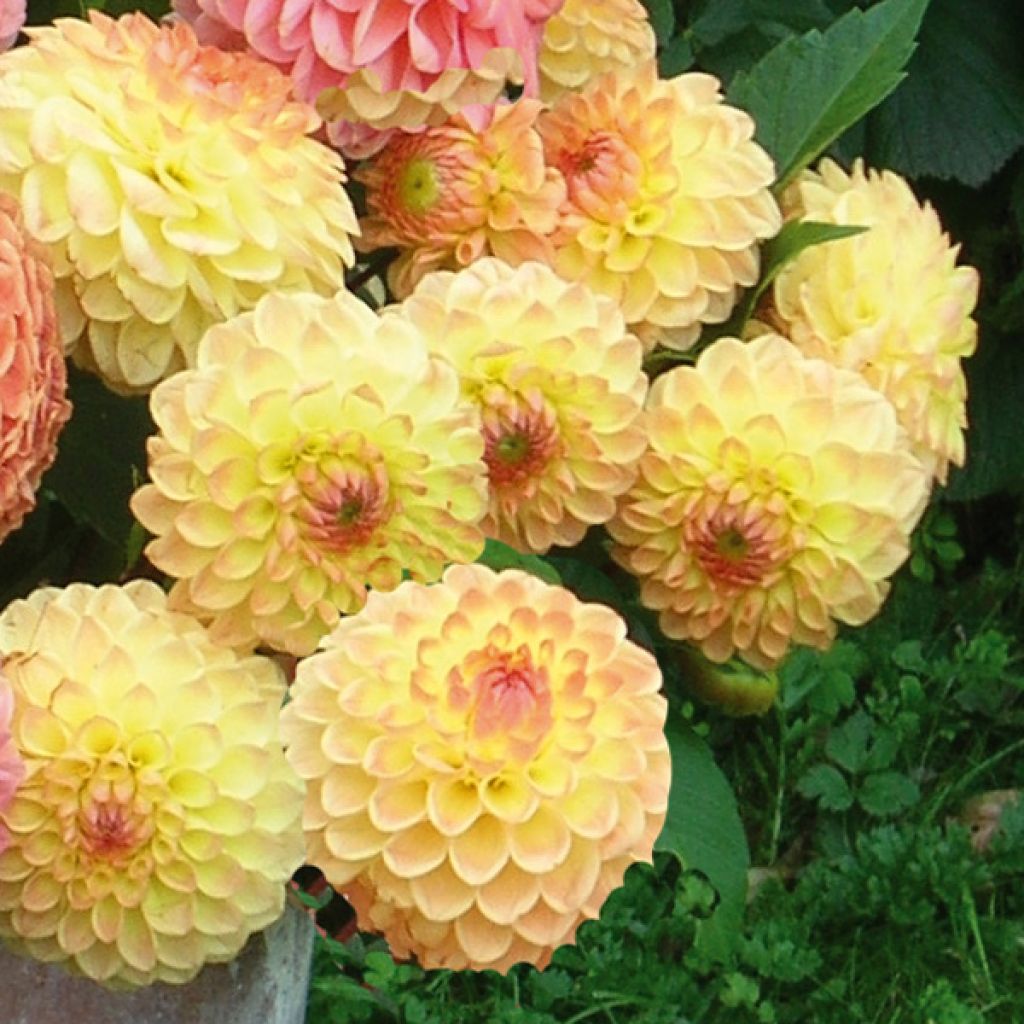

Dahlia Hillcrest Margaret
Dahlia Hillcrest Margaret
Dahlia Hillcrest Margaret
Dahlia
Why not try an alternative variety in stock?
View all →This plant carries a 6 months recovery warranty
More information
We guarantee the quality of our plants for a full growing cycle, and will replace at our expense any plant that fails to recover under normal climatic and planting conditions.
From €5.90 for pickup delivery and €6.90 for home delivery
Express home delivery from €8.90.
Does this plant fit my garden?
Set up your Plantfit profile →
Description
The pompom Dahlia 'Hillcrest Margaret' is a cultivar of impressive size that has long and generous flowering in delicious colours. The numerous flowers, shaped like mini-balls, succeed each other throughout the summer season until autumn and punctuate the flowerbeds with a very sunny yellow, dusted with a very warm apricot shade. Their round shape, made up of multiple petals arranged with exemplary regularity, further enhances these subtle hues. It is also a popular choice for summer bouquets.
Belonging to the Asteraceae family, the Dahlia is a perennial with tubers that is sensitive to frost and needs to be stored away during winter in most of our regions. It appreciates sunny exposures and prefers rich soils for a long and colourful flowering. Its upright and rather bushy habit gives it a place in the flowerbeds alongside all the summer flowers. Its hollow stems can reach a height of up to 1.20 m (4ft) and sometimes require staking. They bear opposite leaves composed of three to five leaflets. With a beautiful deep green colour, they are also slightly shiny and barely dentate. At the top, small globular flowers stand towards the sun. They are made up of numerous rows of concave ligules arranged in a very orderly manner. Very tightly packed in the centre, they are smaller when they bloom, folded in three lengthwise and seem to form an origami heart. As they move towards the outer edges, they grow larger and unfold. The whole flower opens up and easily reaches a diameter of 6 cm (2in), while maintaining an almost perfect symmetry. Their colour, a very vibrant yellow, brings light and cheerfulness to summer compositions. It seems sprinkled with a changing apricot hue that infuses more or less into the tips of the ligules and sometimes blushes.
'Hillcrest Margaret' brings a gentle and warm touch. It will integrate well among a profusion of straw-toned grasses for a natural effect alongside Dahlias 'Honka Yellow' or 'Bishop of Oxford'. It will complete a multicoloured ensemble by bridging the gap between orange and yellow. Don't hesitate to multiply the pompom Dahlias and delve into the collection with a wide choice, you will have cut flowers for the whole summer.
Report an error about the product description
Plant habit
Flowering
Foliage
Botanical data
Dahlia
Hillcrest Margaret
Asteraceae
Dahlia
Cultivar or hybrid
Other Dahlia A to Z
Planting and care
The decorative Dahlia 'Hillcrest Margaret' should be planted after the last frost. For abundant flowering, plant the tubers in full sun in a rich, moist, and well-drained soil. However, waterlogging would promote tuber rot. Amend the soil with compost and sand if necessary. Work the soil deeply and enrich it, for example, with bonemeal. Place your tuber and crumble the soil well to fill without air pockets. Your dahlia should be covered with about 5-6 cm (2in) of soil. At the end of planting, water once abundantly and then regularly renew this watering during the first 6 weeks to aid in rooting. From the moment it is planted, consider staking the dahlia. If the location is unprotected, slightly windy (not too much, if possible), or if it cannot lean on dense and solid neighbours, provide support for this plant. You can also pinch it as it grows to allow it to branch out. Don't forget to remove faded flowers to allow the next ones to develop. Dahlias are sensitive to cold, so they need to be overwintered. In November, the first frosts darken the foliage, which is the time to dig them up. Carefully unearth the tubers. Remove as much soil as possible. Let the foliage dry so that the tubers can replenish their reserves. Then cut the stems to 10 cm (4in). Spread your bulbs in a crate on newspaper. Store them in a frost-free, dry, cool, and dark place, such as a garage or attic. In warmer regions or areas close to the coast, experiencing only a few days of frost per year, it is possible to leave them in place. In this case, simply cover the ground with a carpet of leaves or straw for protection.
Planting period
Intended location
Care
This item has not been reviewed yet - be the first to leave a review about it.
Dahlias
Haven't found what you were looking for?
Hardiness is the lowest winter temperature a plant can endure without suffering serious damage or even dying. However, hardiness is affected by location (a sheltered area, such as a patio), protection (winter cover) and soil type (hardiness is improved by well-drained soil).

Photo Sharing Terms & Conditions
In order to encourage gardeners to interact and share their experiences, Promesse de fleurs offers various media enabling content to be uploaded onto its Site - in particular via the ‘Photo sharing’ module.
The User agrees to refrain from:
- Posting any content that is illegal, prejudicial, insulting, racist, inciteful to hatred, revisionist, contrary to public decency, that infringes on privacy or on the privacy rights of third parties, in particular the publicity rights of persons and goods, intellectual property rights, or the right to privacy.
- Submitting content on behalf of a third party;
- Impersonate the identity of a third party and/or publish any personal information about a third party;
In general, the User undertakes to refrain from any unethical behaviour.
All Content (in particular text, comments, files, images, photos, videos, creative works, etc.), which may be subject to property or intellectual property rights, image or other private rights, shall remain the property of the User, subject to the limited rights granted by the terms of the licence granted by Promesse de fleurs as stated below. Users are at liberty to publish or not to publish such Content on the Site, notably via the ‘Photo Sharing’ facility, and accept that this Content shall be made public and freely accessible, notably on the Internet.
Users further acknowledge, undertake to have ,and guarantee that they hold all necessary rights and permissions to publish such material on the Site, in particular with regard to the legislation in force pertaining to any privacy, property, intellectual property, image, or contractual rights, or rights of any other nature. By publishing such Content on the Site, Users acknowledge accepting full liability as publishers of the Content within the meaning of the law, and grant Promesse de fleurs, free of charge, an inclusive, worldwide licence for the said Content for the entire duration of its publication, including all reproduction, representation, up/downloading, displaying, performing, transmission, and storage rights.
Users also grant permission for their name to be linked to the Content and accept that this link may not always be made available.
By engaging in posting material, Users consent to their Content becoming automatically accessible on the Internet, in particular on other sites and/or blogs and/or web pages of the Promesse de fleurs site, including in particular social pages and the Promesse de fleurs catalogue.
Users may secure the removal of entrusted content free of charge by issuing a simple request via our contact form.
The flowering period indicated on our website applies to countries and regions located in USDA zone 8 (France, the United Kingdom, Ireland, the Netherlands, etc.)
It will vary according to where you live:
- In zones 9 to 10 (Italy, Spain, Greece, etc.), flowering will occur about 2 to 4 weeks earlier.
- In zones 6 to 7 (Germany, Poland, Slovenia, and lower mountainous regions), flowering will be delayed by 2 to 3 weeks.
- In zone 5 (Central Europe, Scandinavia), blooming will be delayed by 3 to 5 weeks.
In temperate climates, pruning of spring-flowering shrubs (forsythia, spireas, etc.) should be done just after flowering.
Pruning of summer-flowering shrubs (Indian Lilac, Perovskia, etc.) can be done in winter or spring.
In cold regions as well as with frost-sensitive plants, avoid pruning too early when severe frosts may still occur.
The planting period indicated on our website applies to countries and regions located in USDA zone 8 (France, United Kingdom, Ireland, Netherlands).
It will vary according to where you live:
- In Mediterranean zones (Marseille, Madrid, Milan, etc.), autumn and winter are the best planting periods.
- In continental zones (Strasbourg, Munich, Vienna, etc.), delay planting by 2 to 3 weeks in spring and bring it forward by 2 to 4 weeks in autumn.
- In mountainous regions (the Alps, Pyrenees, Carpathians, etc.), it is best to plant in late spring (May-June) or late summer (August-September).
The harvesting period indicated on our website applies to countries and regions in USDA zone 8 (France, England, Ireland, the Netherlands).
In colder areas (Scandinavia, Poland, Austria...) fruit and vegetable harvests are likely to be delayed by 3-4 weeks.
In warmer areas (Italy, Spain, Greece, etc.), harvesting will probably take place earlier, depending on weather conditions.
The sowing periods indicated on our website apply to countries and regions within USDA Zone 8 (France, UK, Ireland, Netherlands).
In colder areas (Scandinavia, Poland, Austria...), delay any outdoor sowing by 3-4 weeks, or sow under glass.
In warmer climes (Italy, Spain, Greece, etc.), bring outdoor sowing forward by a few weeks.


































